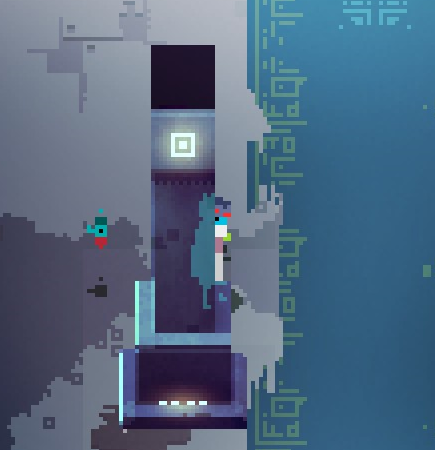All of the drawing code is separated into their own systems responsible for rendering what is on the screen. Differentiate between Lower and Upper layers by naming the layer you want the Entities to be on. I use a custom interface designed to separate the render method of LibGDX into update(delta) and draw(SpriteBatch, delta), similar to C#'s XNA as this was more familiar for me.
You need two fragment shaders and one vertex shader to get the desired result. The vertex shader is a simple passthrough shader:
attribute vec4 a_color;
attribute vec4 a_position;
attribute vec2 a_texCoord0;
uniform mat4 u_projTrans;
varying vec4 v_color;
varying vec2 v_texCoord0;
void main() {
v_color = a_color;
v_color.a = v_color.a * (255.0/254.0);
v_texCoord0 = a_texCoord0;
gl_Position = u_projTrans * a_position;
}
Then you need a fragment shader to discard any pixels from the upper layers with an alpha value of 0 from the Stencil Buffer:
varying vec4 v_color;
varying vec2 v_texCoord0;
uniform sampler2D u_texture;
void main() {
gl_FragColor = v_color * texture2D(u_texture, v_texCoord0);
if (gl_FragColor.a == 0.0) {
discard;
}
}
And finally, another fragment shader to render entity silhouettes:
varying vec4 v_color;
varying vec2 v_texCoord0;
uniform sampler2D u_texture;
void main() {
gl_FragColor = vec4(0.0, 0.75, 1.0, 0.25) * texture2D(u_texture, v_texCoord0).a;
}
Render Lower Tiled Map Layers.
public class LowerTiledMapRenderSystem extends EntitySystem implements Drawable {
private int[] layerIndeces;
private static final OrthogonalTiledMapRenderer renderer = LevelManager.RENDERER;
public LowerTiledMapRenderSystem() {
List<Integer> layers = new LinkedList<>();
for (int i = 0; i < renderer.getMap().getLayers().getCount(); i++) {
if (renderer.getMap().getLayers().get(i).getName().equalsIgnoreCase("entities")) {
layerIndeces = layers.stream().mapToInt(Integer::intValue).toArray();
return;
}
if (renderer.getMap().getLayers().get(i) instanceof TiledMapTileLayer) {
layers.add(i);
}
}
}
@Override
public void draw(SpriteBatch batch, float delta) {
batch.end();
renderer.render(layerIndeces);
batch.begin();
}
}
Render the Entities. This should be simple enough to do depending on how you have your ECS set up.
Render the Upper Map Layers normally, and then to the Stencil Buffer. This is almost identical to the LowerTiledMapRenderSystem, but specifying all layers above the Entities layer instead of below, and also constructing a new ShaderProgram which uses the alphatest shader.
public class UpperTiledMapRenderSystem extends EntitySystem implements Drawable {
ShaderProgram alpha;
private static final OrthogonalTiledMapRenderer renderer = LevelManager.RENDERER;
private int[] layerIndeces;
public UpperTiledMapRenderSystem() {
alpha = Assets.getShader("passthrough", "alphatest");
List<Integer> layers = new LinkedList<>();
for (int i = renderer.getMap().getLayers().getCount() - 1; i > 0; i--) {
if (renderer.getMap().getLayers().get(i).getName().equalsIgnoreCase(Layer.ENTITIES.getName())) {
Collections.reverse(layers);
layerIndeces = layers.stream().mapToInt(Integer::intValue).toArray();
return;
}
if (renderer.getMap().getLayers().get(i) instanceof TiledMapTileLayer) {
layers.add(i);
}
}
}
@Override
public void draw(SpriteBatch batch, float delta) {
batch.end();
// Render normally
renderer.render(layerIndeces);
// Enable the Stencil Buffer
Gdx.gl20.glClear(GL20.GL_STENCIL_BUFFER_BIT);
Gdx.gl20.glEnable(GL20.GL_STENCIL_TEST);
Gdx.gl20.glStencilFunc(GL20.GL_ALWAYS, 0x1, 0xFF);
Gdx.gl20.glStencilOp(GL20.GL_REPLACE, GL20.GL_REPLACE, GL20.GL_REPLACE);
// Set the Shader of the renderer to the alpha shader
renderer.getBatch().setShader(alpha);
// Render the same layers again
renderer.render(layerIndeces);
// Disable the shader
renderer.getBatch().setShader(null);
batch.begin();
}
}
Render the Silhouettes. This is virtually identical to the SpriteRenderSystem, but we're enabling the silhouette shader.
public class SilhouetteRenderSystem extends SortedIteratingSystem implements Drawable {
private final ShaderProgram silhouetteShader;
public SilhouetteRenderSystem() {
super(Family.all(
// Specify components needed here
).get(), new EntityOrderComparator());
silhouetteShader = Assets.getShader("passthrough", "silhouette");
}
@Override
protected void processEntity(Entity entity, float deltaTime) {}
@Override
public void draw(SpriteBatch spriteBatch, float delta) {
Gdx.gl20.glStencilFunc(GL20.GL_LEQUAL, 0x1, 0xFF);
Gdx.gl20.glStencilOp(GL20.GL_KEEP, GL20.GL_KEEP, GL20.GL_KEEP);
spriteBatch.setShader(silhouetteShader);
// Render your entities here
spriteBatch.setShader(null);
Gdx.gl20.glDisable(GL20.GL_STENCIL_TEST);
}
}
I strongly advise looking into OpenGL Documentation to gain a better understanding of how shaders work, specifically glStencilFunc and glStencilOp.

